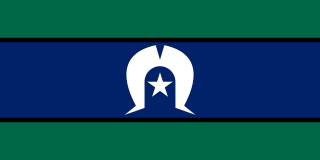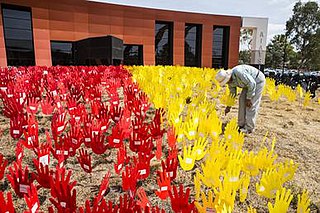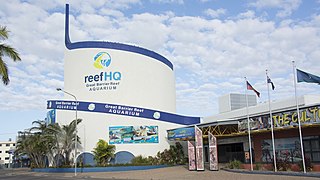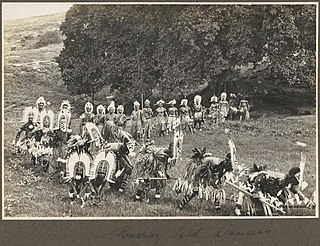Related Research Articles

The Torres Strait Islands are a group of at least 274 small islands which lie in Torres Strait, the waterway separating far northern continental Australia's Cape York Peninsula and the island of New Guinea. The islands span an area of some 48,000 km2 (19,000 sq mi), but the total land area of the islands comprises just 566 km2 (219 sq mi).

Torres Strait Islanders are the Indigenous peoples of the Torres Strait Islands, which are part of the state of Queensland, Australia. Ethnically distinct from the Aboriginal people of the rest of Australia, they are often grouped with them as Indigenous Australians. Today there are many more Torres Strait Islander people living in mainland Australia than on the Islands.

Murray Island is the only town on Meer Island in the Torres Strait Island Region, Queensland, Australia. The island is part of the Murray Island Group in the Torres Strait. The town is on the north-west coast of the island and is within the locality of Mer Island. The island is of volcanic origin, the most easterly inhabited island of the Torres Strait Islands archipelago, just north of the Great Barrier Reef. The name Meer/Mer/Maer comes from the native Meriam language. In the 2016 census, Murray Island had a population of 453 people.
The Mabuiag, or Mabuygiwgal, are an Indigenous Australian group of Torres Strait Islander people united by a common language, strong ties of kinship and survived as skilled hunter–fisher–gatherers in family groups or clans living on a number of Torres Strait Islands including Mabuiag Island, in the Torres Strait in Queensland, Australia. They are ethnically Melanesian.

Palm Island is a locality consisting of an island group of 16 islands, split between the Shire of Hinchinbrook and the Aboriginal Shire of Palm Island, in Queensland, Australia. The locality consists of the Palm Island group, also known as the Greater Palm group, which was originally named the Palm Isles.

The Australian Institute of Aboriginal and Torres Strait Islander Studies (AIATSIS), established as the Australian Institute of Aboriginal Studies (AIAS) in 1964, is an independent Australian Government statutory authority. It is a collecting, publishing and research institute and is considered to be Australia's premier resource for information about the cultures and societies of Aboriginal and Torres Strait Islander peoples. The Institute is a leader in ethical research and the handling of culturally sensitive material and holds in its collections many unique and irreplaceable items of cultural, historical and spiritual significance. The collection at AIATSIS has been built through over 50 years of research and engagement with Aboriginal and Torres Strait Islander communities and is now a source of language and culture revitalisation, native title research and family and community history. AIATSIS is located on Acton Peninsula in Canberra, Australian Capital Territory.

The Queensland Museum is the state museum of Queensland, Australia. The museum currently operates from its headquarters and general museum in South Brisbane with specialist museums located in North Ipswich in Ipswich, East Toowoomba in Toowoomba, and in Townsville City in Townsville.

Aboriginal Australians are the various Indigenous peoples of the Australian mainland and many of its islands, such as Tasmania, Fraser Island, Hinchinbrook Island, the Tiwi Islands, and Groote Eylandt, but excluding the Torres Strait Islands.

North Queensland or the Northern Region is the northern part of the Australian state of Queensland that lies just south of Far North Queensland. Queensland is a massive state, larger than many countries, and the tropical northern part of it has been historically remote and undeveloped, resulting in a distinctive regional character and identity.

Seisia is a coastal town and a locality in the Northern Peninsula Area Region, Queensland, Australia. In the 2016 census, Seisia had a population of 260 people.

Yorke Island, or Masig in the Kalau Lagau Ya language, is a coral cay island of the Torres Strait Islands archipelago, situated in the eastern area of the central island group in the Torres Strait, at the top end of the Great Barrier Reef and northeast of the tip of Cape York Peninsula in Queensland, Australia.

Reef HQ is the world's largest living coral reef aquarium. It is located in Townsville, Queensland, Australia. The aquarium was built as a Bicentennial Commemorative project and is a part of the Great Barrier Reef Marine Park Authority (GBRMPA). The Coral Reef Exhibit has 130 coral species and 120 fish species along with hundreds of species of sea stars, sea urchins, sea cucumbers, brittle stars, feather stars, snails, worms and sponges.
Indigenous Australians are people with familial heritage to groups that live or lived in Australia and surrounding islands before, during or after British colonisation of Australia. They include the Aboriginal and Torres Strait Islander peoples of Australia. The term Aboriginal and Torres Strait Islander people is also generally accepted; First Nations of Australia, First Peoples of Australia and First Australians are also common terms.

Henrietta Marrie is an Australian indigenous rights activist. She is an Aboriginal Australian from the Yidinji tribe, directly descended from Ye-i-nie, an Aboriginal leader in the Cairns region. In 1905, the Queensland Government awarded Ye-i-nie with a king plate in recognition of his local status as a significant Walubara Yidinji leader.
Danie Mellor is an Australian artist who was the winner of the 2009 National Aboriginal & Torres Strait Islander Art Award. Born in Mackay, Queensland, Mellor grew up in Scotland, Australia, and South Africa before undertaking tertiary studies at North Adelaide School of Art, the Australian National University (ANU) and Birmingham Institute of Art and Design. He then took up a post lecturing at Sydney College of the Arts. He works in different media including printmaking, drawing, painting, and sculpture. Considered a key figure in contemporary Indigenous Australian art, the dominant theme in Mellor's art is the relationship between Indigenous and non-Indigenous Australian cultures.

Great Palm Island, usually known as Palm Island, is the largest island in the Palm Islands group off Northern Queensland, Australia. It is known for its Aboriginal settlement, once an Aboriginal reserve, which is also known by a variety of other names including "the Mission", Palm Island Settlement or Palm Community. The original inhabitants of the island were the Manbarra, also known as the Wulgurukaba. The island is also sometimes called Bwgcolman, from the name recently given to the Aboriginal people from disparate groups who were deported from many areas of the Queensland mainland to the reserve.

Kaurareg is the name for one of the Indigenous Australian groups collectively known as Torres Strait Islander peoples. They are lower Western Islanders, based on the Muralag group. In common with the other peoples of the Torres Strait Island, they commanded impressive sailing outrigger canoe technology, traded throughout the Straits, fishing and trading with other Torres Strait Island groups. Similarly, they also regularly visited the Australian mainland of Cape York Peninsula, and retained ceremonial, marriage and trading alliances with several Aboriginal Australian groups there. Subject to reprisals after being blamed for an incident in which a Western schooner and its crew were destroyed, their numbers rapidly diminished with the onset of white colonisation and administration. After World War II, descendants of the Kaurareg began to return to their traditional islands, and lay claim to native title over several of them.

Mabo: Life of an Island Man is a 1997 documentary on the life of Indigenous Australian land rights campaigner Eddie Koiki Mabo.
The Dreamtime Cultural Centre is an Indigenous cultural arts and education centre in Rockhampton, Queensland, Australia.
Ken Thaiday, known as Ken Thaiday Snr, is an artist from Erub, one of the Torres Strait Islands. He is known for his headdresses, masks, shark totems and kinetic sculptures, which connect to his island traditions and culture.
References
- 1 2 3 4 5 6 Ian Frazer Mixed feelings Long-time campaigners for a cultural centre for indigenous people, Ernie and Maud Hoolihan say the new centre is not the meeting place they envisaged 30 years ago but it's better than nothing. Townsville Bulletin Weekend extra published 14 January 2006 p38
- ↑ Townsville Bulletin Opening postponed published 12 July 2005 p3
- 1 2 Townsville Sun Community Newspaper School's over let's get to it published 20 July 2005 p8
- ↑ Kerri-Anne Mesner Artists primed to tap into tourism market Townsville Sun Community Newspaper published 15 June 2005 p11
- ↑ "TATSSICC Newsletter September 2005" (PDF). Retrieved 16 January 2007.
- ↑ Andy Toulson Building on culture Townsville Bulletin published 19 January 2005 p8
- ↑ Leonie Johnson Bless this centre Cultures run deep at spiritual opening Townsville Bulletin published 23 May 2005 p5